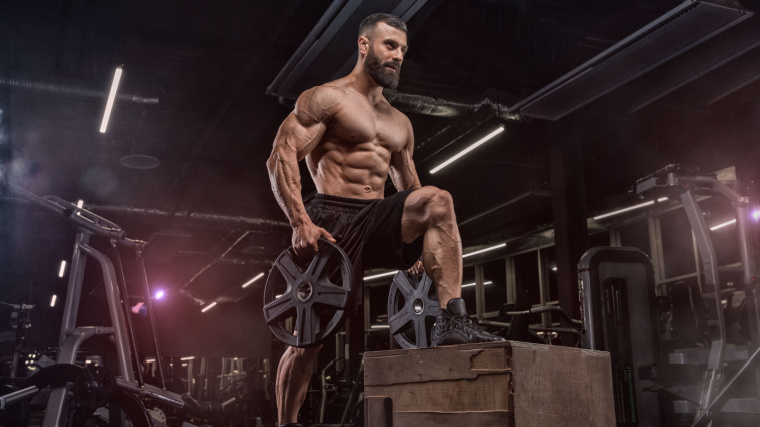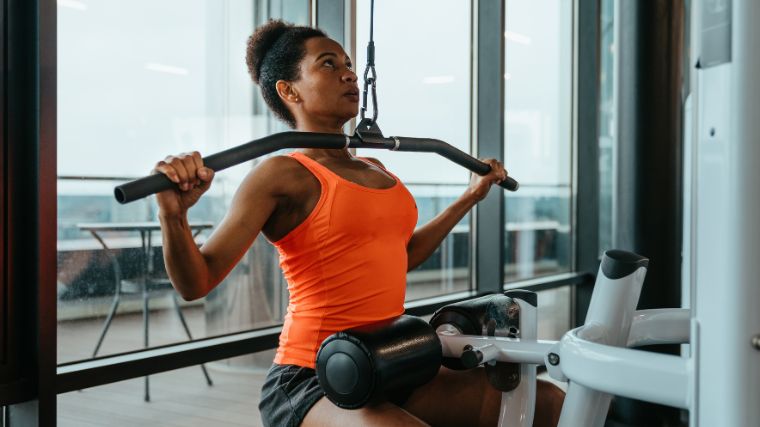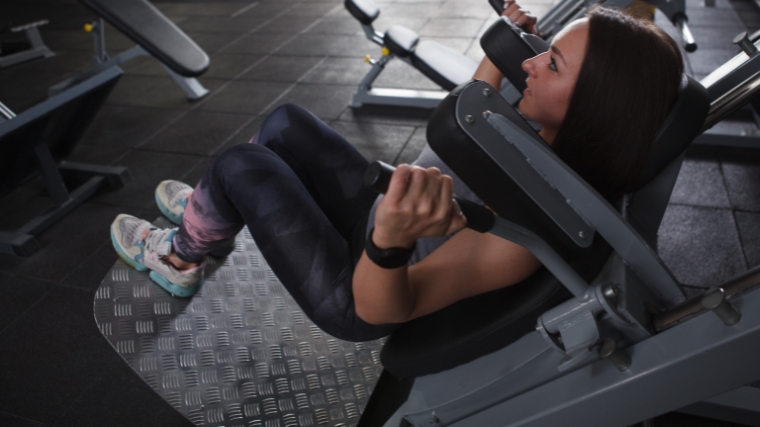Some things just belong together: peanut butter & jelly, chicken and rice, milk and cookies and, when it comes to your workout routine, certain muscle groups. Most strength training workouts are divided into splits, which divide up your various muscles across the number of days you hit the weights.
This begs the question — what are the best muscle group combos? Is there a logistical or physiological difference between training your chest with your back compared to your legs?

If you’re in the gym to build muscle, gain strength, get flexible, or simply improve your overall health, there’s no good reason to haphazardly throw a workout together. Knowing which muscle groups work best as a pair will improve your quality of life in the gym in more ways than you might think. Here are a few of the best muscle group combinations to workout together:
The Best Muscle Group Combinations
- Chest and Back
- Legs and Shoulders
- Legs and Arms
- Chest and Shoulders
- Biceps and Triceps
- Abs, Forearms, and Calves
Chest and Back
Your chest and back — that is, your pectoralis muscles and the various tissues across your upper back like your latissimus dorsi and rhomboids — antagonize each other. That doesn’t mean they’re enemies, it just means they perform many opposing anatomical functions.
It may seem counterintuitive, but antagonistic pairings are ideal for most resistance training workouts. You can alternate between a chest-focused “pushing” movement and a back-focused “pulling” exercise, or bang out all of one before moving onto the other.

[Read More: The Ultimate 10-Week Powerbuilding Workout Routine for Mass and Strength]
Antagonistic pairings like this tend to be great for developing a good pump, and may even help your joints feel a bit better; using your shoulders to row and pull prior to heavy pressing will help warm them up in advance.
Sample Chest and Back Workout
There are two main options for pairing chest and back exercises together in the same workout. You can “stack” all your exercises for one muscle group together, or alternate between them. The stacking method tends to be a bit better for muscle hypertrophy, while alternating between pulls and presses should help you emphasize your strength.
- Barbell Bench Press: 3 x 5
- Incline Dumbbell Bench Press: 3 x 8
- Cable Flye: 2 x 12
- Wide-Grip Lat Pulldown: 3 x 8
- Upright Row: 2 x 12
- Dumbbell Pullover: 2 x 15
[Related: Build a Titanic Torso with These Bodybuilding Chest & Back Workouts]
- Dumbbell Bench Press: 3 x 8
- Dumbbell Row: 3 x 8
- Incline Bench Press: 2 x 12
- Seated Cable Row: 2 x 12
- Cable Flye: 2 x 15
- Face Pull: 2 x 20
Legs and Shoulders
Another thing to consider when pairing muscle groups together is how much energy you have to work with in the gym. Larger, more complex muscle groups demand more time, attention, and effort than smaller ones.
As such, it may be unwise to train your legs (which have the largest and most powerful muscles in your body) with another beefy muscle group like your back. You’re likely to run out of gas before you hit the finish line.
[Read More: Try These Dumbbell Shoulder Workouts to Build Strength, Size, or Get Flexible]
Instead, try something like legs and shoulders. Not only are these two muscle groups regionally distinct and share zero functional overlap, but your shoulder muscles are much smaller and perform more discrete actions. Hitting your delts before you head to the squat rack won’t leave you gasping for air.
Sample Leg and Shoulder Workout
Whether you train legs or shoulders first during the workout is up to you. Whichever muscle group needs more attention or is a physique weak point is the one you should prioritize. Generally speaking, starting your workout with large compound exercises is generally preferable. Here’s how that might look in practice:
- Back Squat or Leg Press: 4 x 8
- Romanian Deadlift or Good Morning: 2 x 12
- Split Squat or Leg Extension: 2 x 15
- Leg Curl: 2 x 20
- Dumbbell Shoulder Press: 3 x 12
- Dumbbell Lateral Raise: 3 x 15
- Rear Delt Flye: 2 x 25
Legs and Arms
You can also organize your training into limb or torso-focused workouts. Pairing legs and arms together works for the same reason that shoulders and legs do; they’re disparate regions of your body and have hardly any overlap.
However, there’s a caveat. There aren’t any gym exercises that work your biceps and triceps (the two main muscles in your arms) at the same time, since they’re responsible for performing opposing actions.

[Read More: The Best Quad Exercises and Quad Workouts for Muscle Gain]
This means that you’ll need to do all of your leg training, then some biceps curls, then some triceps-specific exercises as well. This can add up to quite a bit of time spent in the weight room.
Sample Leg and Arm Workout
To pack all your training into a single c and still have time left over for the rest of your day, you may need to take it easy on the leg exercises somewhat. Here’s a sample workout that adequately trains every muscle in both your legs and arms:
- Hack Squat or Leg Press: 3 x 8
- Stiff-Leg Deadlift: 2 x 12
- Lateral Lunge: 2 x 15
- Box Jump: 5 x 5
- Dumbbell Curl: 2 x 8
- Preacher Curl: 2 x 12
- Skull Crusher: 2 x 8
- Overhead Cable Extension: 2 x 15
Chest and Shoulders
While pairing antagonistic or opposing muscle groups together offers many advantages, it’s certainly not the only way to go about organizing your workout plan. In fact, heading in the opposite direction can yield some surprising results.
[Read More: 5 Bench Press Programs to Build a Bigger, Stronger Chest]
Working two muscle groups that perform similar functions in the same session can help you double-down on your strengths and gain extra muscle along the way. Nowhere is this better evident than a good old fashioned “push day” in which you train your chest and shoulders together.
Sample Chest and Shoulder Workout
Since your chest and shoulders are deeply synergistic muscle groups, you don’t have to worry too much about how you order your exercises during the workout. Work from “big” to “small” and you’ll hit every muscle fiber in your pecs and delts along the way. Here’s a sample:
- Incline Barbell Bench Press: 4 x 8
- Dumbbell Shoulder Press: 3 x 8
- Dumbbell Hex Press: 2 x 12
- Cable or Dumbbell Flye: 3 x 15
- Dumbbell Lateral Raise: 3 x 15
- Face Pull: 2 x 20
Biceps and Triceps
Nothing beats a good gun run. Smashing your arms to bits with the right isolation exercises will have you leaving the gym feeling like Arnold Schwarzenegger himself. Beyond the sheer enjoyment of it, pairing your biceps training with your triceps work makes sense economically as well.

[Read More: Try This Shoulder and Biceps Workout to Build Muscle]
Both muscles act to bend or straighten your elbow joint, so it just makes good intuitive sense to perform an arm-only workout if growing or strengthening those muscles is a priority. What’s more, arm exercises are typically pretty grab-and-go. You don’t need complex equipment for an arm workout. There’s a lot you can do with your bare hands and a few dumbbells.
Sample Biceps and Triceps Workout
Whether you perform all your curls before your presses, or alternate between a biceps and triceps movement, is up to you. The former will let you focus all your might on fully fatiguing one muscle before moving on, while the latter produces an unparalleled pump. Here’s how this looks in practice:
- Incline Dumbbell Curl: 3 x 8
- Bayesian Cable Curl: 2 x 12
- Reverse-Grip Preacher Curl: 2 sets to failure
- Cable Triceps Pressdown: 3 x 8
- Cable Overhead Extension: 2 x 12
- Dumbbell Kickback: 2 sets to failure
[Related: The Best Shoulder Exercises for Building Muscle]
- Cheat Curl: 3 x 6
- Skull Crusher: 3 x 8
- Rope Hammer Curl: 3 x 12
- Rope Pressdown: 3 x 12
- Preacher Curl: 2 x 15
- Seated Single-Arm Dumbbell Overhead Extension: 2 x 15
Abs, Forearms, and Calves
A good workout split accounts for more than just your meat and potatoes. Setting up a leg day or a chest workout is easy, but finding time in your schedule to address the smaller or overlooked muscles matters just as much.
[Read More: How to Perform a Picture-Perfect Sit-Up for Stronger Abs]
Muscles like your abs, forearms, and calves tend to fall by the wayside in some workout routines. Sure, large compound movements hit these muscles incidentally, but a bit of direct love can help too. What’s more, hitting your “accessory” muscles in the same workout will take much less time than if you tacked them onto an already-long workout.
Sample Ab, Forearm, and Calf Workout
A good “accessory day” can have you in and out of the gym in about half an hour. You can even consider these muscles a form of active recovery, since training them induces very little overall fatigue. Here’s how an ab, forearm, and calf workout might look as part of your overall routine:
- Standing Calf Raise + Dumbbell Wrist Curl: 3 x 15 each, as a superset
- Seated Calf Raise + Dumbbell Wrist Extension: 3 x 15 each, as a superset
- Cable Crunch: 4 x 12
- Hanging Leg Raise: 3 sets to failure
More Training Content
- How to Use a Massage Gun, According to a PT
- Demystifying Your Fat-Burning Heart Rate Zone
- The 8 Best Wrist Mobility Exercises to Help You Lift Heavier Barbells
Featured Image: Lebedev Roman Olegovich / Shutterstock